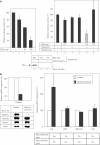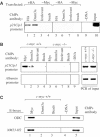Myc represses transcription through recruitment of DNA methyltransferase corepressor
- PMID: 15616584
- PMCID: PMC545804
- DOI: 10.1038/sj.emboj.7600509
Myc represses transcription through recruitment of DNA methyltransferase corepressor
Abstract
The Myc transcription factor is an essential mediator of cell growth and proliferation through its ability to both positively and negatively regulate transcription. The mechanisms by which Myc silences gene expression are not well understood. The current model is that Myc represses transcription through functional interference with transcriptional activators. Here we show that Myc binds the corepressor Dnmt3a and associates with DNA methyltransferase activity in vivo. In cells with reduced Dnmt3a levels, we observe specific reactivation of the Myc-repressed p21Cip1 gene, whereas the expression of Myc-activated E-boxes genes is unchanged. In addition, we find that Myc can target Dnmt3a selectively to the promoter of p21Cip1. Myc is known to be recruited to the p21Cip1 promoter by the DNA-binding factor Miz-1. Consistent with this, we observe that Myc and Dnmt3a form a ternary complex with Miz-1 and that this complex can corepress the p21Cip1 promoter. Finally, we show that DNA methylation is required for Myc-mediated repression of p21Cip1. Our data identify a new mechanism by which Myc can silence gene expression not only by passive functional interference but also by active recruitment of corepressor proteins. Furthermore, these findings suggest that targeting of DNA methyltransferases by transcription factors is a wide and general mechanism for the generation of specific DNA methylation patterns within a cell.
Figures





References
-
- Amati B, Frank SR, Donjerkovic D, Taubert S (2001) Function of the c-Myc oncoprotein in chromatin remodeling and transcription. Biochim Biophys Acta 1471: M135–M145 - PubMed
-
- Bachman KE, Rountree MR, Baylin SB (2001) Dnmt3a and Dnmt3b are transcriptional repressors that exhibit unique localization properties to heterochromatin. J Biol Chem 276: 32282–32287 - PubMed
-
- Bestor T, Laudano A, Mattaliano R, Ingram V (1988) Cloning and sequencing of a cDNA encoding DNA methyltransferase of mouse cells. The carboxyl-terminal domain of the mammalian enzymes is related to bacterial restriction methyltransferases. J Mol Biol 203: 971–983 - PubMed
Publication types
MeSH terms
Substances
LinkOut - more resources
Full Text Sources
Other Literature Sources
Molecular Biology Databases

